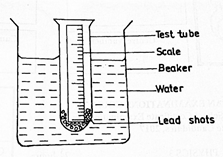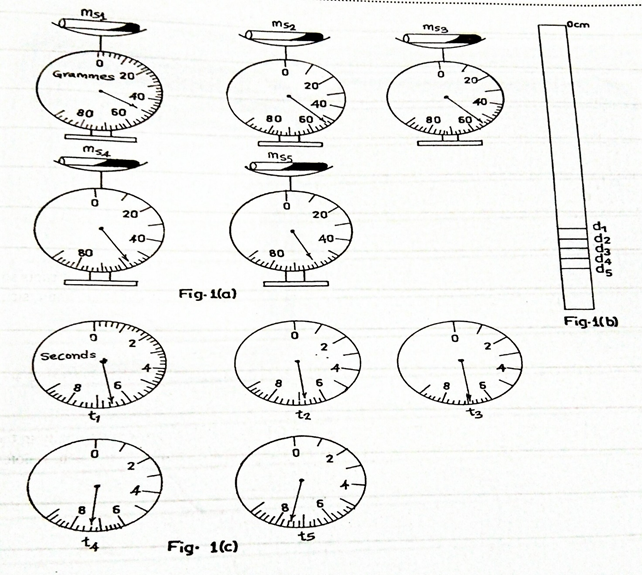Question 1A

A test tube is weighed and its mass mo = 20 g is recorded. It is then loaded with sufficient lead shots so that it floats vertically in a beaker of water as shown in the diagram above. The depth, d, of immersion of the test tube and content is measured and recorded
The test tube and content are taken out of the water, weighed and the mass ms read and recorded. The mass ml of the lead shot is determined and recorded. The quantity
is then evaluated and recorded.
The test tube and its content are returned into water. The test tube is slightly depressed vertically in the water and released so that it performs vertical oscillations. The time, t for 10 complete oscillations is noted and recorded.
The procedure is repeated four other times by increasing the mass ml of the lead shot in the test tube.
Fig. 1(a) shows the masses msi of the test tube and its contents, Fig 1(b) shows the corresponding depths di of immersion and Fig 1(c) shows the corresponding time ti for ten (10) complete vertical oscillations of the test tube in the wate, where I = 1, 2, 3, 4 and 5.
- Read and record the masses msi of the loaded test tube and the depth di of immersion.
- Read and record the corresponding time ti for ten (10) complete oscillations.
- Evaluate in each case, the mass ml of the lead shots and the period T of oscillation.
Also, evaluate and
- Tabulate your readings.
- Determine the mean Q of Li.
- Plot a graph of ml on the vertical axis and T2 on the horizontal axis.
- Determine the slope s, of the graph and the intercept c, on the vertical axis.
- Evaluate , taking π as .
- State two precautions that are necessary to ensure accurate results when performing this experiment
(b) (i) List the forces acting on the loaded test-tube as it performs vertical oscillation in the water
(ii) Explain why the amplitude of oscillation of a loaded test tube decreases with time
Observation
Part (a) Candidates performance below average. However, many candidates did not start the graph of ml against T2 from the origin as was required by the question, hence, they could not determine the intercept on the ml axis.
Part (b) The question was fairly attempted. Some candidates could not explain why the amplitude of oscillation of a loaded test tube decreases with time.
The expected response is that candidates should:
- correctly read and record in gram five values of ms
- correctly measure and record to at least 1 d.p and within tolerance of ± 0.1 cm five values of d.
- correctly evaluate five values of ml= ms – mo
correctly read and record to at least 1 d.p and within tolerance of ± 0.1 second, five values of t for 10 complete oscillations
- Plot a graph using reasonable scales
- draw line of best it
- determine the slope and intercept of the graph
- state any two of the following precautions.
e.g.
- Avoided/avoid parallax error in reading weighing balance/stop clock/stop watch
- Repeated readings stated/repeat readings
- Noted/note zero error on metre rule/stop clock/stop watch
In part b, the expected answers are:
b(i) Forces Acting on the Loaded Test tube
Weight/Gravitational force
Upthrust
Viscous force or liquid friction
(ii) The amplitude of oscillation of a loaded test tube decreases with time because of the liquid friction/viscous force which opposes the motion.
